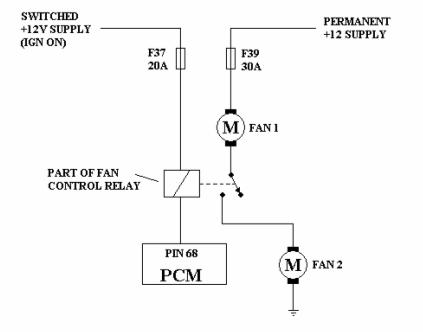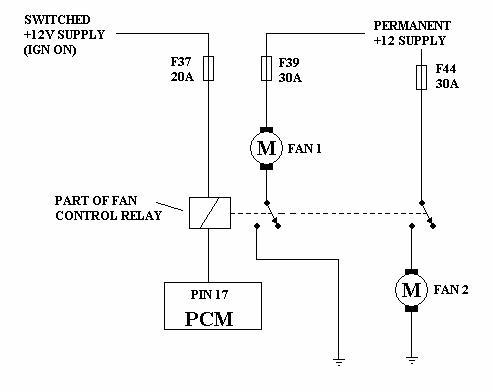Coolant Fans Circuit
All Scorpios made between 1994 and 1998 achieve the cooling of the radiator
by means of an electrical two speed twin fan system. Unlike other cars (for
example the Mercedes W124), the same fans are also used to cool down the
condenser while the air conditioning system is running. Depending on the engine
type, the fans can be controlled either by a thermal switch mounted on the
radiator (2.9 12V or 2.5 TD), or by the PCM (DOHC2.0 8V and 16V, DOHC2.3,
Cosworth 2.9 24V).
One point should be clear right from the beginning: both fans must either
run simultaneously or not run at all. You should never have only one
running fan.
Also, the fans only work while the engine is running. They must never stay on
after stopping the engine, like in other cars (e.g. some Renaults).
Since the cooling fans are also used for air conditioning, they run on low speed
whenever the A/C is on, regardless of the engine temperature. If they run on
high speed with the A/C on while the engine is cold, this indicates a
refrigerant pressure problem.
The fans work as follows:
• Engine stopped => both fans off
• Engine cold, A/C off => both fans off
• Engine cold or warm, A/C on => both fans running on low speed
• Engine hot, regardless of A/C => both fans running on high speed
With an OBD lead you can see what the PCM is currently ordering the fans to do.
On the Enhanced page there are two PIDs: LFC (low speed fan command) and HFC
(high speed fan command). If LFC is ON, the fans should be running on low speed.
If HFC is ON, the fans should be running on high speed.
You’ll notice that the high speed command does NOT cancel the low speed command.
As long as the conditions for low speed are met, low speed command stays on even
if high speed has come on in the meantime. When we look at the relay diagram
we’ll see that this has actually no practical meaning.
The PCM controls the fans by means of a relay, located in the engine
compartment. The FINIS code of the relay is 1-030-495.
12V AND DIESEL MODELS
Owners of the 12V and 2.5 TDi diesels will find a three-way switch
(Normal, Temp 1 and Temp 2) and these instructions do not apply to them. The
circuit is the same but uses the switch instead of the PCM.
EECV MODELS
For the EECV-equipped cars, (the two DOHC 2.0L models, the 2.3L and the 24V)
there is no temperature switch. In fact the fans are connected in series
in usual use, sharing six volts each which results in the low speed running.
There is no fan thermister switch - instead the temparture of the coolant is
sensed by the EECV Powertrain Control Module via the ECT.
The following is an explanation of the coolant fans circuit.
FANS ON LOW SPEED OPERATION

On the above diagram you can see the wiring path that is used when the fans run
in slow speed.
On the right hand side of the circuit you can see there is a permanent supply
through fuse 39 into the first fan. The relay is open so both fans are off.
When the PCM wants the fans to run slow it energises the relay by grounding pin
68 to earth.
The relay has a switched live feed to its coil from the ignition switch. This
prevents the fans coming on if the ignition is off.
When the relay is energised the contacts close and the two fans are connected in
series. This means that the 12v supply is split evenly between the 2 fans
and so they get 6v each. This is what makes the fans turn slowly.
This diagram is for all cars except 2.9 12v and diesel. They have a 3 way temp
switch, Normal, Temp1, Temp2. The circuit is the same but uses this switch
instead of the PCM.
FANS ON HIGH
SPEED

The above diagram
is for FAST SPEED. It is basically the same as before but note each fan has its
own fuse and the relay is switching fan 1 direct to earth and is switching 12v
to fan 2.
Each fan now has 12v across it’s terminals and runs at maximum speed. The PCM
grounds pin 17 to activate the fast speed.
One interesting point is worth noticing here. When the fans run on low speed
they are connected in series, which means they cannot run independently from one
another. If one of the fans is not working due to some electrical problem, then
the other one won’t work either. However, on high speed they are connected in
parallel, so even if one fan does not work the other one will. If one fan stops
running for mechanical reasons (a worn out bearing, for example) but the
electrical connections are OK, the other fan will continue to run even in low
speed mode, but it will receive more than 6V, so it will run faster than
supposed to, probably at almost full speed.
You can use the OBDII cable and software to monitor the PCM outputs to the fan
relay whilst you are driving and you can see if they are being commanded to run
slow or fast.
Fuses
• Fuse no. 37 controls the energizing and de-energizing of the relay. If it
burns out, both fans will always be off, since the PCM will have no way of
turning them on, neither on low speed nor on high speed.
• Fuse no. 39 controls both fans on low speed and the first fan on high speed.
If it burns out, none of the fans will work on low speed, and only the second
fan will work on high speed.
• Fuse no. 44 controls the second fan on high speed. If it burns out, both fans
will work on low speed, but only the first fan will work on high speed.
Component
location
All three fuses are located in the auxiliary fuse box, next to the battery.
The relay, which is long (much bigger than common relays) and dark green
coloured, can be found in the engine compartment, immediately behind the right
hand headlight. It’s attached by means of a screw.
The first fan’s plug is located below the fan, very close to it, and can only be
accessed from beneath the car, after removing the undertray.
The second fan’s plug is located near the fan and to the right (as seen from the
front to the back of the car). It can be easily accessed without raising the
vehicle, but you have to remove the resonator box first.
SYMPTOM

